Diffusive Representation: A Powerful Method to Analyze Temporal Signals from Metal-Oxide Gas Sensors Used in Pulsed Mode
Abstract
1. Introduction
2. Experimental
2.1. Micro-Hotplate Metal Oxide Gas Sensor
2.2. Experimental Setup
2.3. Experimental Protocol
3. Results and Discussion
3.1. Polynomial Modeling
3.2. Neural Network Modelling
3.3. Diffusive Representation
3.3.1. Model Presentation
3.3.2. Used Model
- To set the system order (N). It is the number of state variables X and the number of values ξ.
- To define ξ, specific variables to the frequency domain. We have to define the number of decades on which our model is used (respecting the Shannon’s theorem). Then, we calculate the values of our vector for the number N, between frequencies terminals defined, for a logarithmic spacing between points.
- To provide a set of input/output measurements.
3.3.3. Model Optimizations
3.3.4. Model Performance for the Interpolation
4. Conclusions
Author Contributions
Funding
Institutional Review Board Statement
Informed Consent Statement
Data Availability Statement
Acknowledgments
Conflicts of Interest
References
- Wang, C.; Yin, L.; Zhang, L.; Xiang, D.; Gao, R. Metal oxide gas sensors: Sensitivity and influencing factors. Sensors 2010, 10, 2088–2106. [Google Scholar] [CrossRef]
- Burresi, A.; Fort, A.; Rocchi, S.; Serrano, B.; Ulivieri, N.; Dynamic, V.V. CO recognition in presence of interfering gases by using one MOX sensor and a selected temperature profile. Sens. Actuators B 2005, 106, 40–43. [Google Scholar] [CrossRef]
- Cavicchi, R.E.; Suehle, J.S.; Kreider, K.G.; Gaitan, M.; Chaparala, P. Optimized temperaturepulse sequences for the enhancement of chemically specific response patterns from microhotplate gas sensors. Sens. Actuators B 1996, 33, 142–146. [Google Scholar] [CrossRef]
- Schweizer-Berberich, M.; Zdralek, M.; Weimar, U.; Göpel, W.; Viard, T.; Martinez, D.; Seube, A.; Peyre-Lavigne, A. Pulsed mode of operation and artificial neural network evaluation for improving the CO selectivity of SnO2 gas sensors. Sens. Actuators B 2000, 65, 91–93. [Google Scholar] [CrossRef]
- Montoliu, I.; Tauler, R.; Padilla, M.; Pardo, A.; Marco, S. Multivariate curve resolution applied to temperature-modulated metal oxide gas sensors. Sens. Actuators B 2010, 145, 464–473. [Google Scholar] [CrossRef]
- Lee, A.P.; Reedy, B.J. Temperature modulation in semiconductor gas sensing. Sens. Actuators B 1999, 60, 35–42. [Google Scholar] [CrossRef]
- Hosseini-Golgoo, S.M.; Hossein-Babaei, F. Assessing the diagnostic information in the response patterns of a temperature-modulated tin oxide gas sensor. Meas. Sci. Technol. 2011, 22, 035201. [Google Scholar] [CrossRef]
- Hossein-Babaei, F.; Amini, A. A breakthrough in gas diagnosis with a temperature-modulated generic metal oxide gas sensor. Sens. Actuators B 2012, 166-167, 419–425. [Google Scholar] [CrossRef]
- Ponzoni, A.; Depari, A.; Comini, E.; Faglia, G.; Flammini, A.; Sberveglieri, G. Response dynamics of metal oxide gas sensors working with temperature profile protocols. Procedia Eng. 2011, 25, 1173–1176. [Google Scholar] [CrossRef]
- Varpula, A.; Novikov, S.; Haarahiltunen, A.; Kuivalainen, P. Transient characterization techniques for resistive metal-oxide gas sensors. Sens. Actuators B 2011, 159, 12–26. [Google Scholar] [CrossRef]
- Parret, F.; Menini, P.; Martinez, A.; Soulantica, K.; Maisonnat, A.; Chaudret, B. Improvement of micromachined SnO2 gas sensors selectivity by optimised dynamic temperature operating mode. Sens. Actuators B 2006, 118, 276–282. [Google Scholar] [CrossRef]
- Vergara, A.; Llobet, E.; Brezmes, J.; Ivanov, P.; Cane, C.; Gracia, I.; Vilanova, X.; Correig, X. Quantitative gas mixture analysis using temperature-modulated micro-hotplate gas sensors: Selection and validation of the optimal modulating frequencies. Sens. Actuators B 2007, 123, 1002–1016. [Google Scholar] [CrossRef]
- Ionescu, R.; Hoel, A.; Granqvist, C.G.; Llobet, E.; Heszler, P. Ethanol and H2S gas detection in air and in reducing and oxidizing ambience: Application of pattern recognition to analyse the output from temperature-modulated nanoparticulate WO3 gas sensors. Sens. Actuators B 2005, 104, 124–131. [Google Scholar] [CrossRef]
- Jaegle, M.; Wollenstein, J.; Meisinger, T.; Bottner, H.; Muller, G.; Becker, T.; Braunmuhl, C.B. Micromachined thin film SnO2 gas sensors in temperature-pulsed operation mode. Sens. Actuators B 1999, 57, 130–134. [Google Scholar] [CrossRef]
- Frietsch, M.; Zudock, F.; Goschnick, J.; Bruns, M. CuO catalytic membrane as selectivity trimmer for metal oxide gas sensors. Sens. Actuators B 2000, 65, 379–381. [Google Scholar] [CrossRef]
- Musatov, V.Y.; Sysoev, V.V.; Sommer, M.; Kiselev, I. Close-to-practice assessment of meat freshness with metal oxide sensor microarray electronic nose. AIP Conf. Proc. 2009, 1137, 469–472. [Google Scholar]
- Tomchenko, A.A.; Harmer, G.P.; Marquis, B.T.; Allen, J.W. Semiconducting metal oxide sensor array for the selective detection of combustion gases. Sens. Actuators B 2003, 93, 126–134. [Google Scholar] [CrossRef]
- Zhang, Q.; Xie, C.; Zhang, S.; Wang, A.; Zhu, B.; Wang, L.; Yang, Z. Identification and pattern recognition analysis of Chinese liquors by doped nano ZnO gas sensor array. Sens. Actuators B 2005, 110, 370–376. [Google Scholar] [CrossRef]
- Huang, J.; Wan, Q. Gas Sensors Based on Semiconducting Metal Oxide One-Dimensional Nanostructures. Sensors 2009, 9, 9903–9924. [Google Scholar] [CrossRef]
- Siripatrawan, U. Rapid differentiation between E. coli and Salmonella Typhimurium using metal oxide sensors integrated with pattern recognition. Sens. Actuators B 2008, 133, 414–419. [Google Scholar] [CrossRef]
- Setkus, A.; Olekas, A.; Senuliene, D.; Falasconi, M.; Pardo, M.; Sberveglieri, G. Featuring of odor by metal oxide sensor response to varying gas mixture. AIP Conf. Proc. 2009, 1137, 202–205. [Google Scholar]
- Yin, Y.; Tian, X. Classification of Chinese drinks by a gas sensors array and combination of the PCA with Wilks distribution. Sens. Actuators B 2007, 124, 393–397. [Google Scholar] [CrossRef]
- Lee, D.; Huh, J.; Lee, D. Classifying combustible gases using micro-gas sensor array. Sens. Actuators B 2003, 93, 1–6. [Google Scholar] [CrossRef]
- Barsan, N.; Weimar, U. Conduction Model of Metal Oxide Gas Sensors. J. Electroceram. 2001, 7, 143–167. [Google Scholar] [CrossRef]
- Barsan, N.; Weimar, U. Understanding the fundamental principles of metal oxide based gas sensors; the example of CO sensing with SnO2 sensors in the presence of humidity. J. Phys. Condens. Matter 2003, 15, 813–839. [Google Scholar] [CrossRef]
- Ding, J.; McAvoy, T.J.; Cavicchi, R.E.; Semancik, S. Surface state trapping models for SnO2-based microhotplate sensors. Sens. Actuators B 2001, 77, 597–613. [Google Scholar] [CrossRef]
- el Barbria, N.; Amaria, A.; Vinaixab, M.; Bouchikhia, B.; Correigb, X.; Llobet, E. Building of a metal oxide gas sensor-based electronic nose to assess the freshness of sardines under cold storage. Sens. Actuators B 2007, 128, 235–244. [Google Scholar] [CrossRef]
- Galdikas, A.; Mironas, A.; Senulien, D.; Strazdien, V.; Setkus, A.; Zelenin, D. Response time based output of metal oxide gas sensors applied to evaluation of meat freshness with neural signal analysis. Sens. Actuators B 2000, 69, 258–265. [Google Scholar] [CrossRef]
- Lv, P.; Tang, Z.; Wei, G.; Yu, J.; Huang, Z. Recognizing indoor formaldehyde in binary gas mixtures with a micro gas sensor array and a neural network. Meas. Sci. Technol. 2007, 18, 2997. [Google Scholar] [CrossRef]
- Vlachos, D.S.; Fragoulis, D.K.; Avaritsiotis, J.N. An adaptive neural network topology for degradation compensation of thin film tin oxide gas sensors. Sens. Actuators B 1997, 45, 223–228. [Google Scholar] [CrossRef]
- Lee, D.S.; Jung, H.Y.; Lim, J.W.; Lee, M.; Ban, S.W.; Huh, J.S.; Lee, D.D. Explosive gas recognition system using thick film sensor array and neural network. Sens. Actuators B 2000, 71, 90–98. [Google Scholar] [CrossRef]
- Fine, G.F.; Cavanagh, L.M.; Afonja, A.; Binions, R. Metal oxide semi-conductor gas sensors in environmental monitoring. Sensors 2010, 10, 5469–5502. [Google Scholar] [CrossRef]
- Balasubramanian, S.; Panigrahi, S.; Logue, C.M.; Gu, H.; Marchello, M. Neural networksintegrated metal oxide-based artificial olfactory system for meat spoilage Identification. J. Food Eng. 2009, 91, 91–98. [Google Scholar] [CrossRef]
- Srivastava, A.K. Detection of volatile organic compounds (VOCs) using SnO2 gas-sensor array and artificial neural network. Sens. Actuators B 2003, 96, 24–37. [Google Scholar] [CrossRef]
- Casenave, C. Time-local formulation and identification of implicit Volterra models by use of diffusive representation. Automatica 2011, 10, 2273–2278. [Google Scholar] [CrossRef][Green Version]
- Allard, B.; Jorda, X.; Bidan, P.; Rumeau, A.; Morel, H.; Perpina, X.; Vellvehi, M.; M’Rad, S. Reduced-order thermal behavioral model based on diffusive representation. IEEE Trans. Power Electron. 2009, 24, 2833–2846. [Google Scholar] [CrossRef]
- Montseny, G. Diffusive representation of pseudo-differential time-operators. ESAIM Proc. Fract. Differ. Syst. Models Methods Appl. 1998, 5, 159–175. [Google Scholar] [CrossRef]
- Montseny, G.; Mbodje, B. Optimal models of fractional integrators and application to systems with fading memory. Syst. Man Cybern. 1993, 5, 65–70. [Google Scholar]
- Garcia, G.; Bernussou, J. Identification of the dynamics of the lead acid battery by a diffusive model. ESAIM Proc. Fract. Differ. Syst. Models Methods Appl. 1998, 5, 87–98. [Google Scholar] [CrossRef]
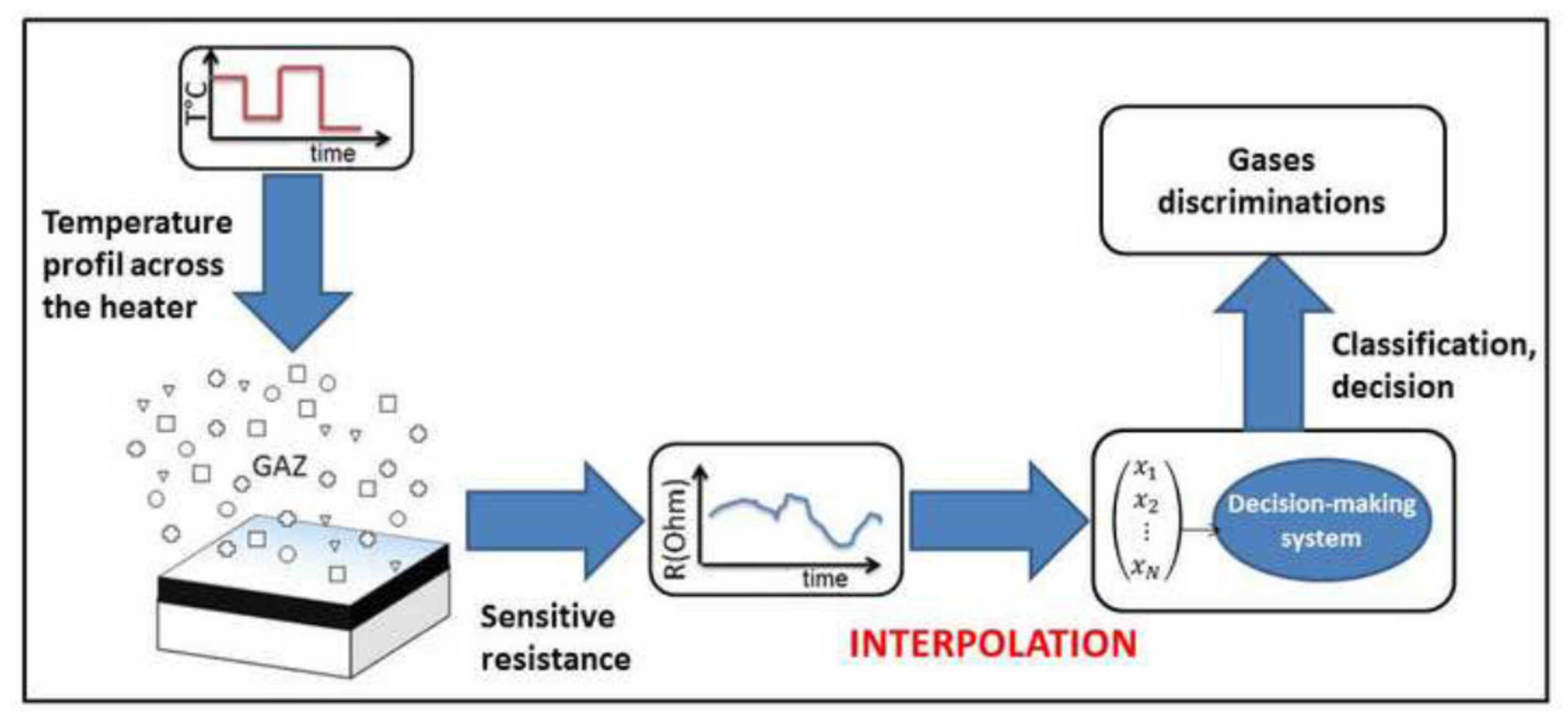
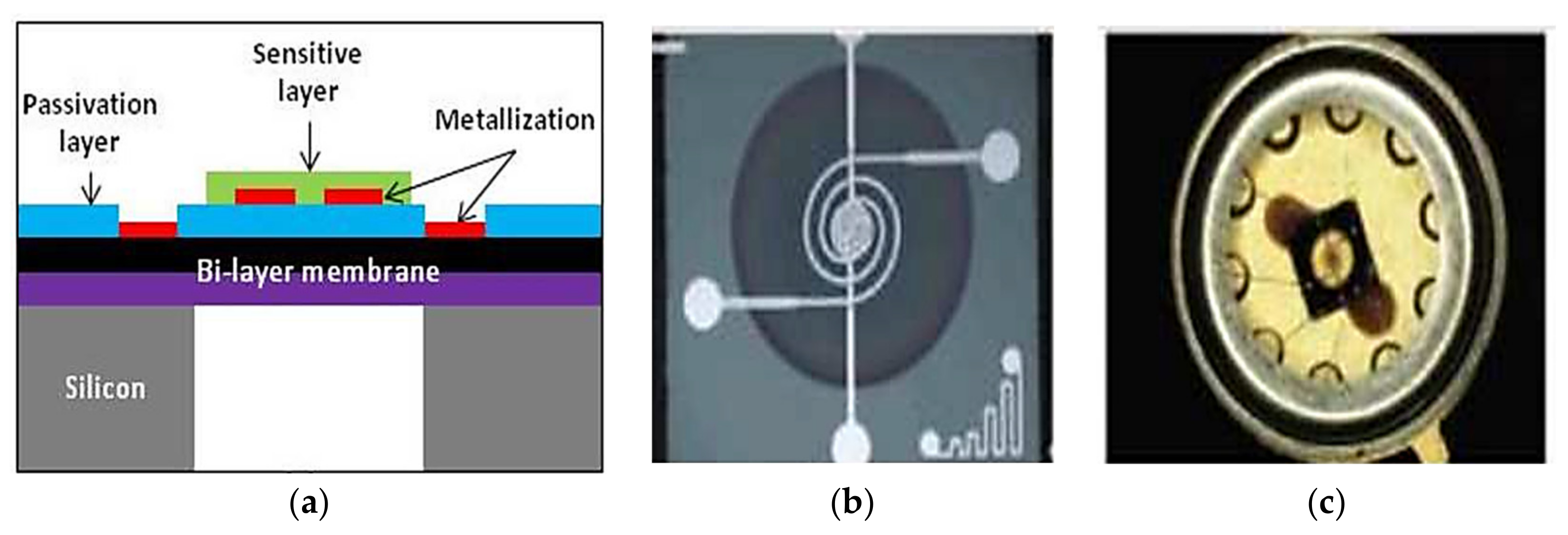

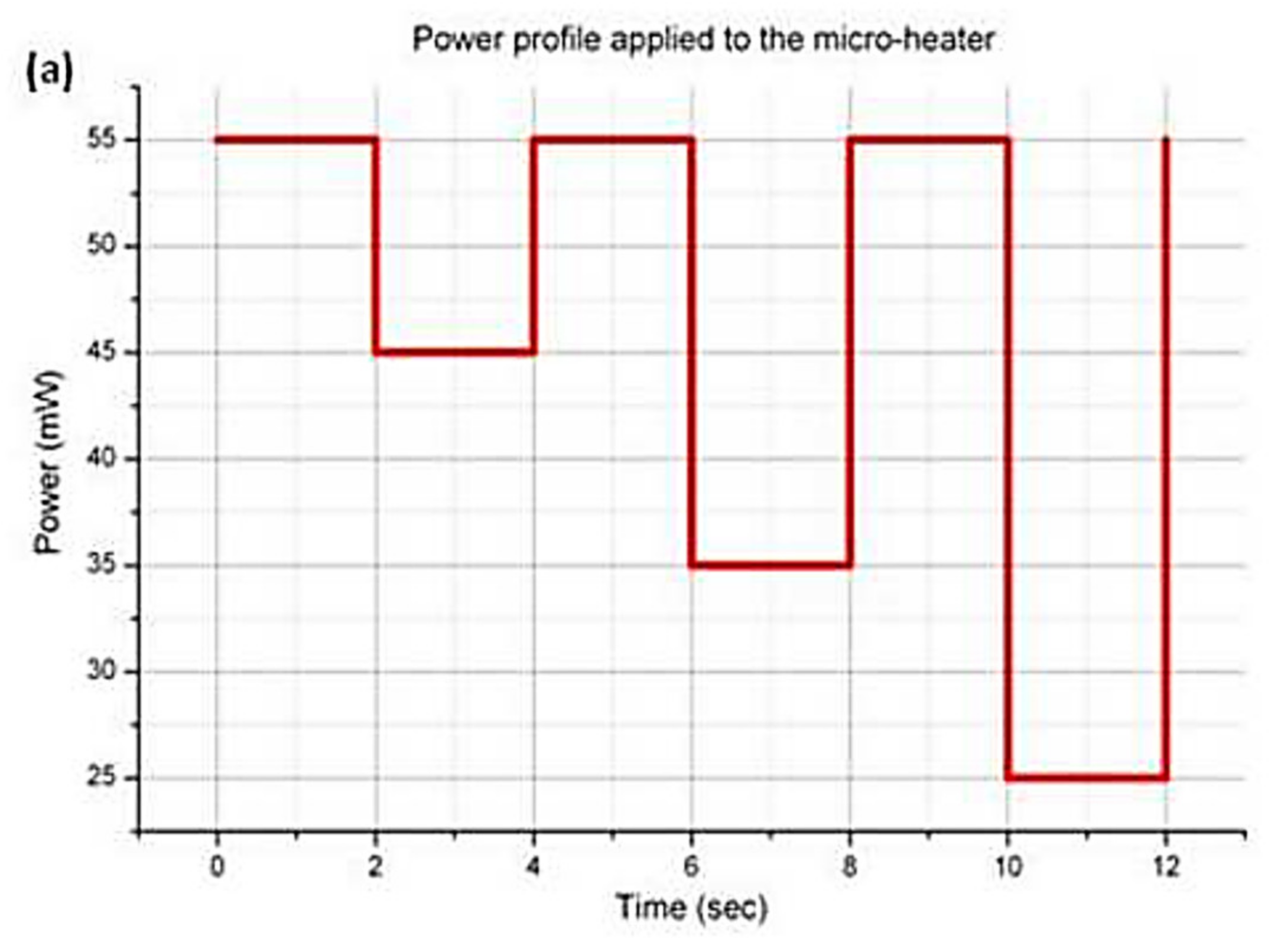


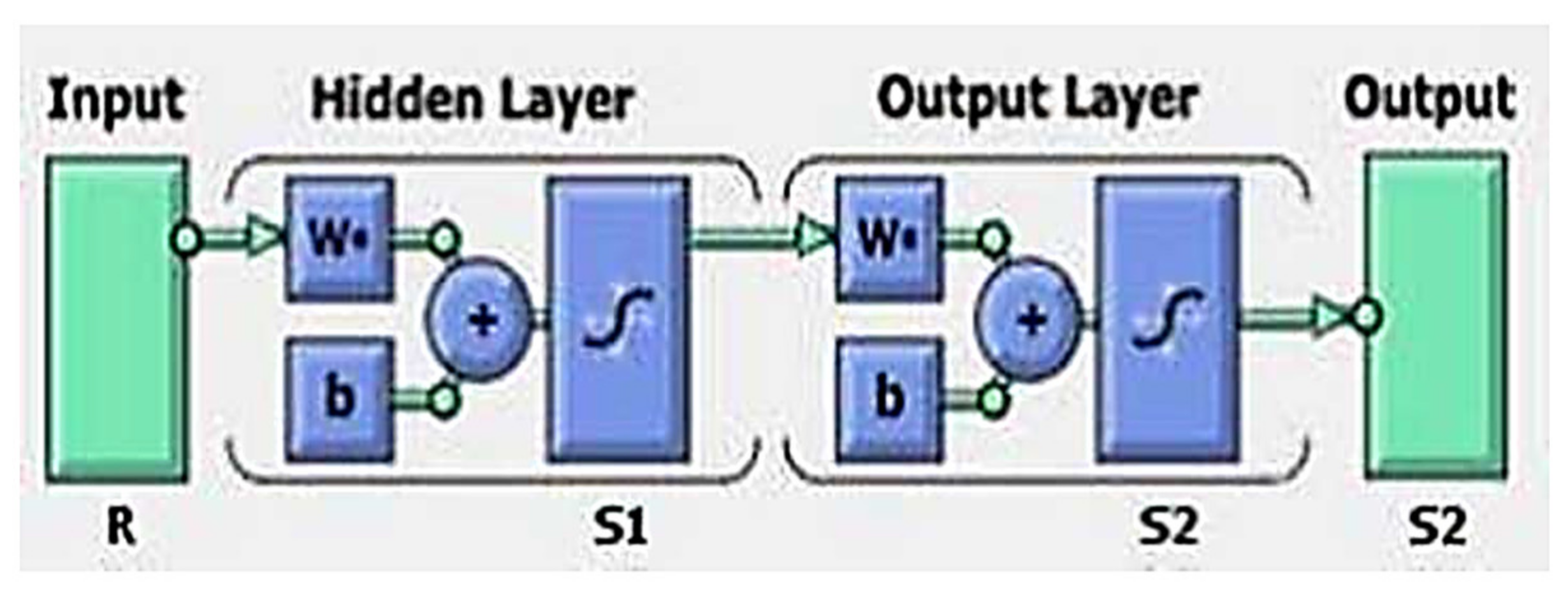
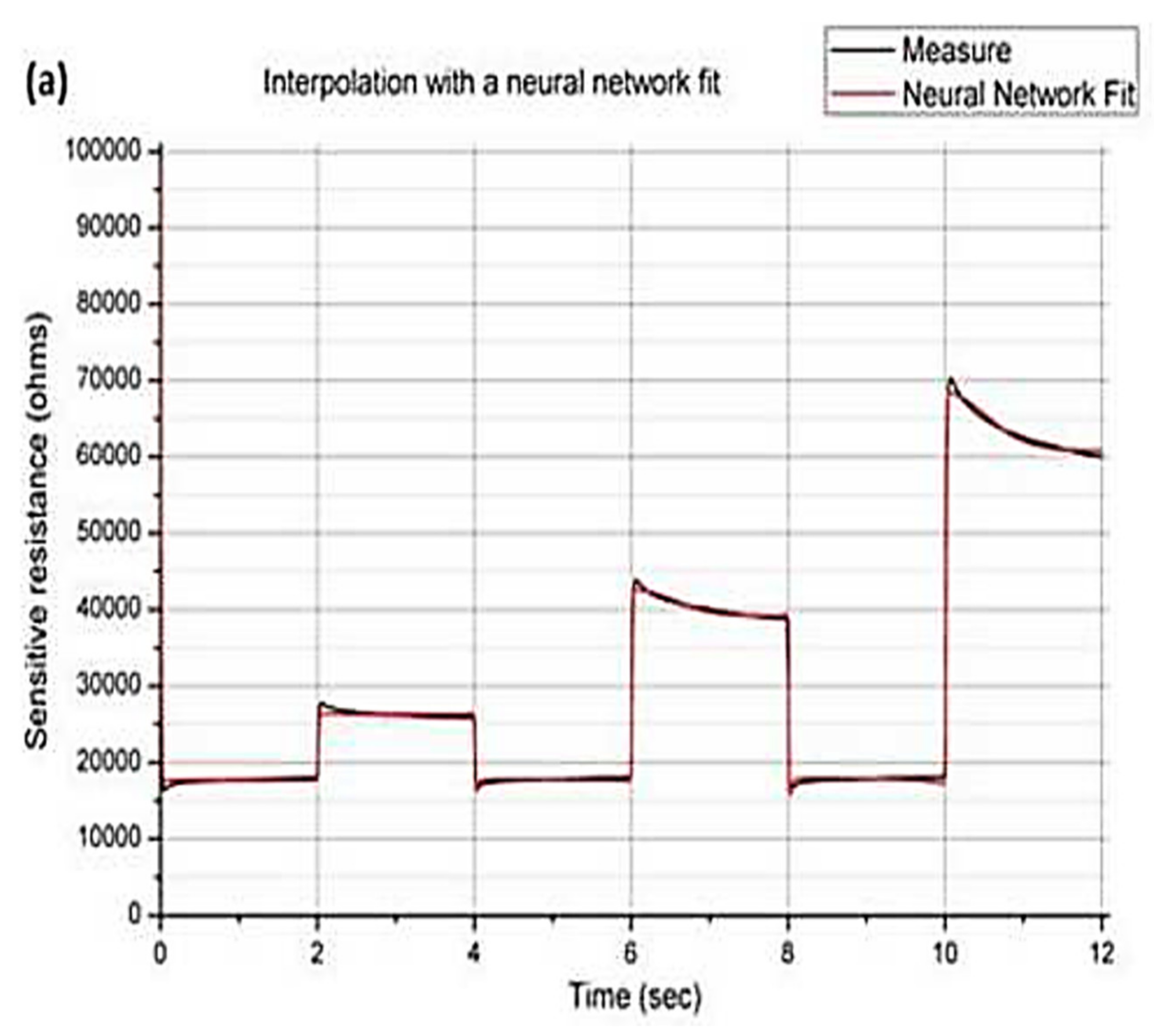

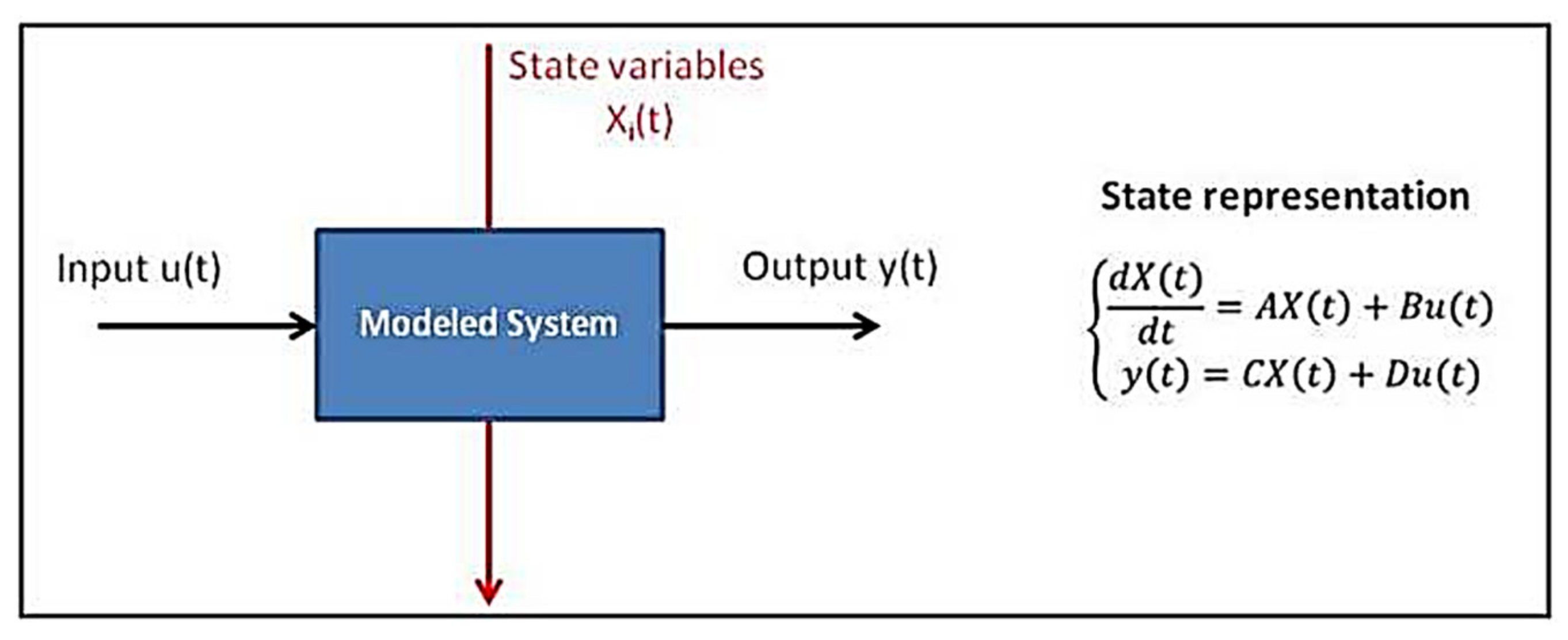
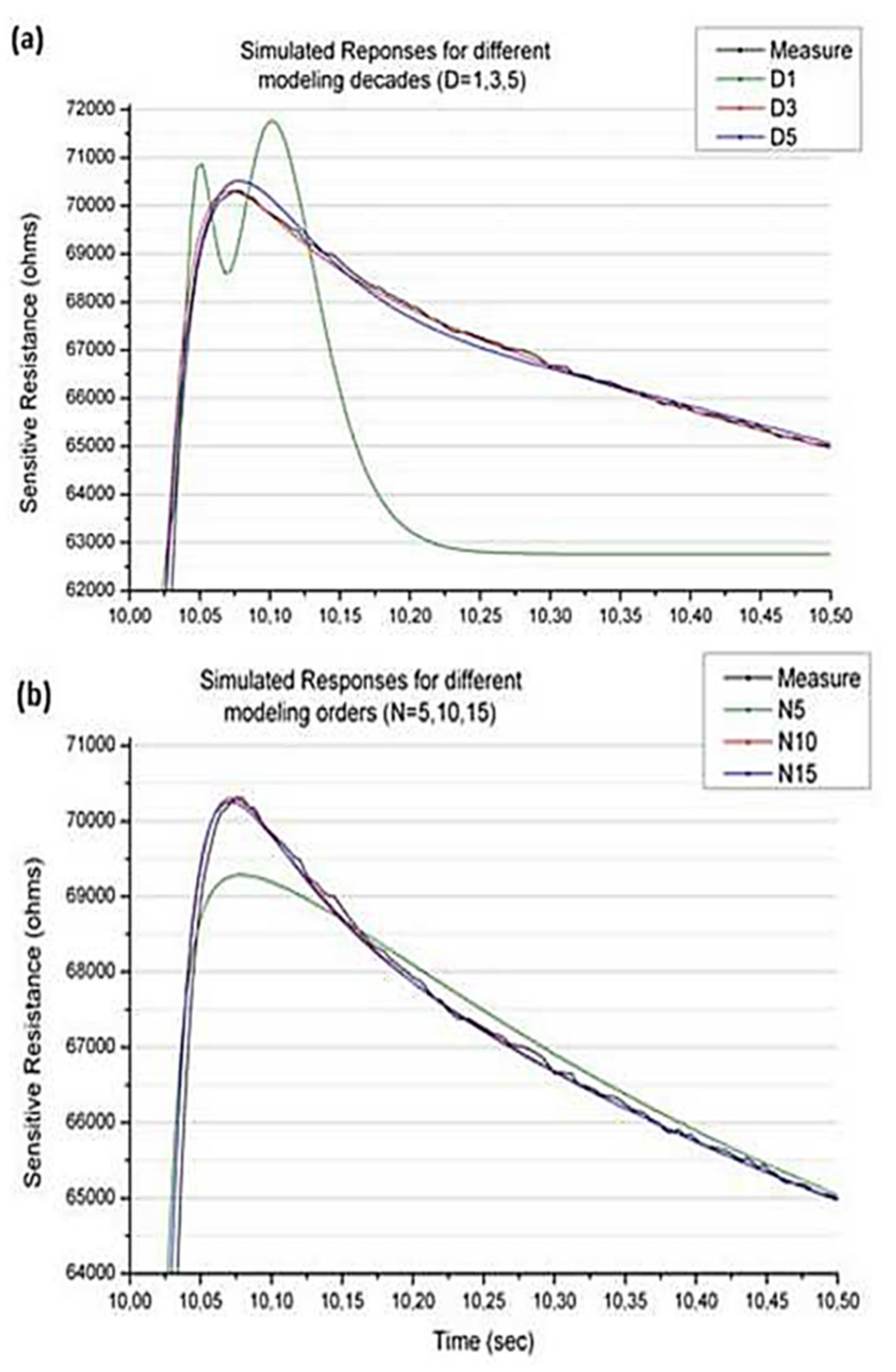
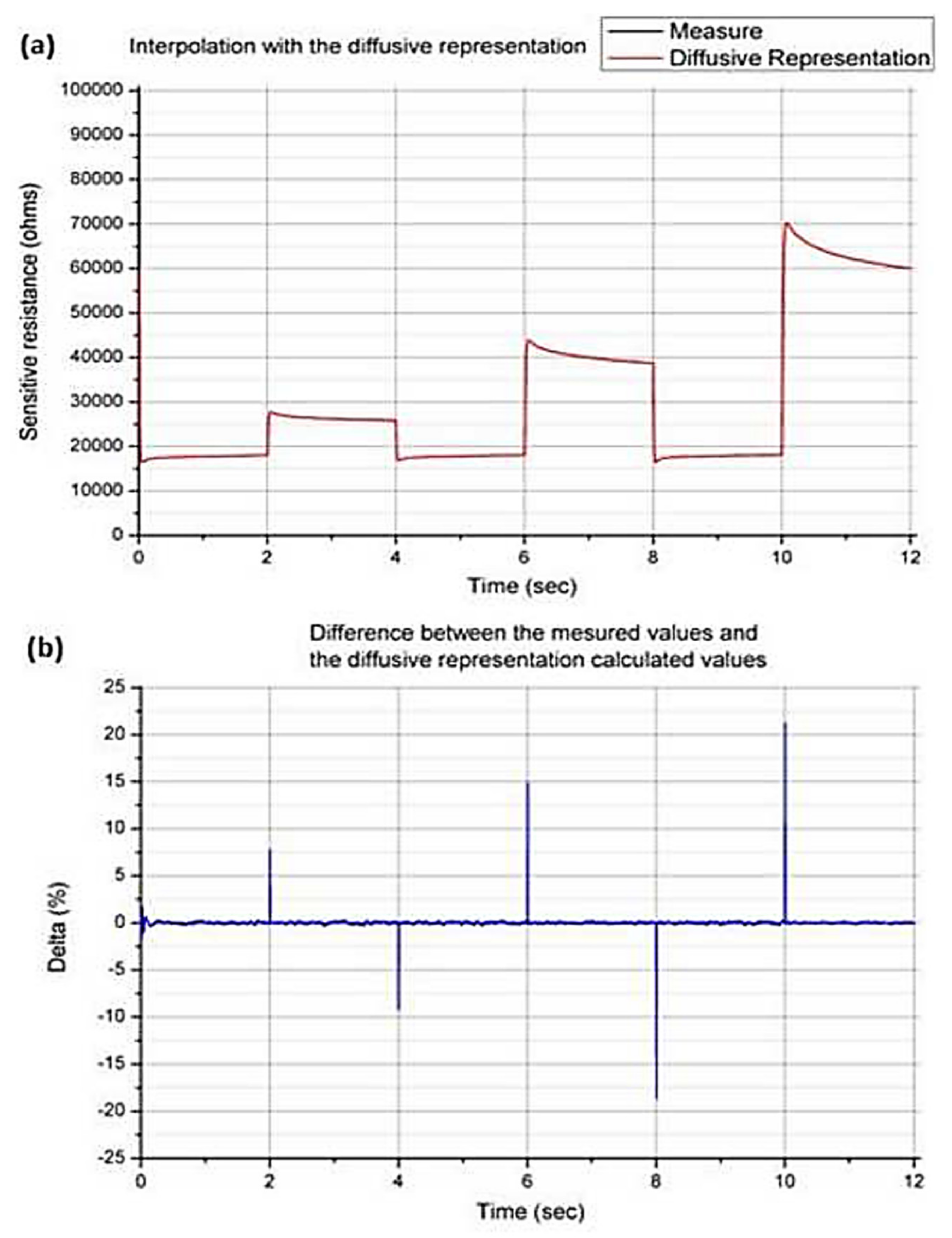
Publisher’s Note: MDPI stays neutral with regard to jurisdictional claims in published maps and institutional affiliations. |
© 2021 by the authors. Licensee MDPI, Basel, Switzerland. This article is an open access article distributed under the terms and conditions of the Creative Commons Attribution (CC BY) license (https://creativecommons.org/licenses/by/4.0/).
Share and Cite
Tropis, C.; Dufour, N.; Garcia, G.; Montseny, G.; Talhi, C.; Blanc, F.; Franc, B.; Menini, P. Diffusive Representation: A Powerful Method to Analyze Temporal Signals from Metal-Oxide Gas Sensors Used in Pulsed Mode. Electronics 2021, 10, 2578. https://doi.org/10.3390/electronics10212578
Tropis C, Dufour N, Garcia G, Montseny G, Talhi C, Blanc F, Franc B, Menini P. Diffusive Representation: A Powerful Method to Analyze Temporal Signals from Metal-Oxide Gas Sensors Used in Pulsed Mode. Electronics. 2021; 10(21):2578. https://doi.org/10.3390/electronics10212578
Chicago/Turabian StyleTropis, Cyril, Nicolas Dufour, Germain Garcia, Gerard Montseny, Chaabane Talhi, Frédéric Blanc, Bernard Franc, and Philippe Menini. 2021. "Diffusive Representation: A Powerful Method to Analyze Temporal Signals from Metal-Oxide Gas Sensors Used in Pulsed Mode" Electronics 10, no. 21: 2578. https://doi.org/10.3390/electronics10212578
APA StyleTropis, C., Dufour, N., Garcia, G., Montseny, G., Talhi, C., Blanc, F., Franc, B., & Menini, P. (2021). Diffusive Representation: A Powerful Method to Analyze Temporal Signals from Metal-Oxide Gas Sensors Used in Pulsed Mode. Electronics, 10(21), 2578. https://doi.org/10.3390/electronics10212578






